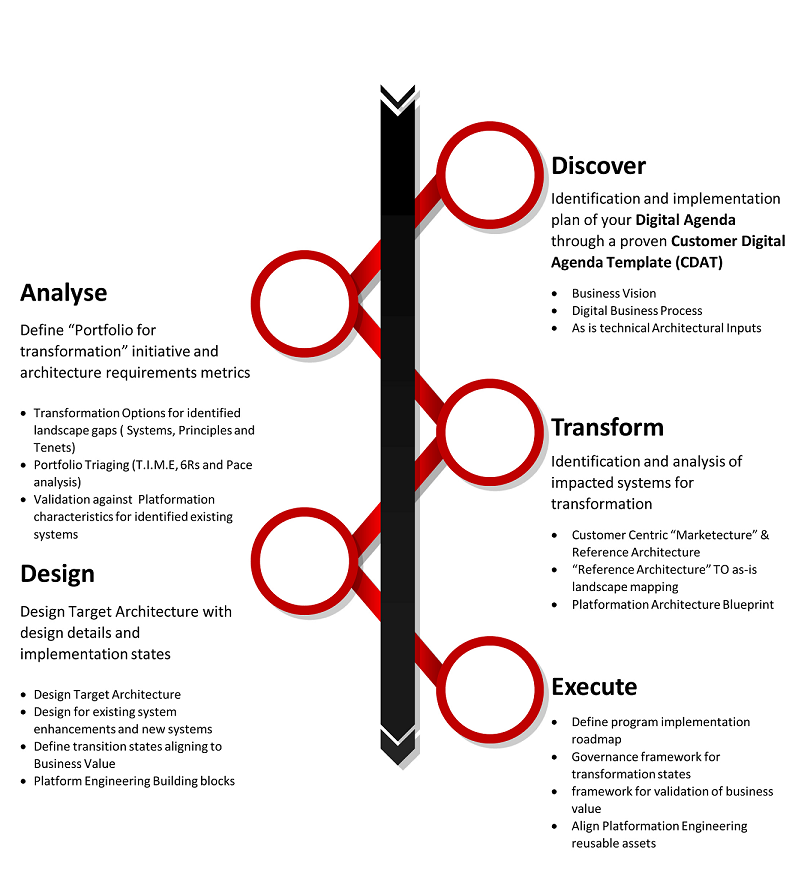Platform Engineering Story
Platform Based Business Model
Modern, digitally empowered businesses have been successful in rapid disruption and value creation, through platforms. Global enterprises, ensure competitive advantage, enduring customer relations and revenue growth, need to embark on digital business transformation initiatives. They need to create new digital businesses or transform existing ones to platform-based business models. McKinsey in its February article titled `The Platform Play: How to Operate like a Tech Company', explains this concept articulately, "Becoming a platform-based company is ultimately a question of mind-set. It requires both the determination to stay the course and the flexibility to change and adjust based on what platform teams learn. By committing to this approach, IT can stop slowing down change and start accelerating it".
Highlights of platform-based business models:
- Creates/enhances and facilitates the ecosystem, facilitates value exchange between different stakeholders in the ecosystem.
- Ensures that enterprises can coexist with disruptive and legacy business models while embracing new digital initiatives.
- Extracts untapped value from existing organizational assets/systems and combines with new capabilities to stimulate meaningful engagement with stakeholders.
Creating platforms in traditional enterprises requires the ability to architect, design, develop, maintain and enhance platforms as per the digital agenda. These platforms should be based on modern technology stack, be cloud-based and have the ability to integrate with existing systems. Sonata helps create these platforms to accelerate digital transformation by building, extending and enhancing developing and managing platforms that adhere to OPEN, SCALABLE, CONNECTED and INTELLIGENT platform characteristics.
This document provides details of Sonata's Platformation offering - Custom Platform Engineering, and where it has been successfully used to help customers adapt Platformation.
How Sonata Can help achieve PBBM
Sonata has a well-defined seven step methodology to help enterprises to adopt a platform-based business model:
- Platform Maturity Assessment: Sonata conducts digital, business and technology assessment , benchmarks industry best practices, and reports recommendations
- Customer Digital Agenda: Sonata creates the digital agenda for the enterprise and provides its recommendation for business transformation.
- Platform Ecosystem & Design Thinking : Sonata, adapting the `Design Thinking' process, co-creates the platform ecosystem & business model by mapping and identifying participant journeys, pains, gains and opportunities.
- Digital Business Processes: Digital Business Process library for the enterprise is created along with `As Is – To Be' gap analysis. Based on these recommendations, future business processes and MARCHITECTURE SONATA SOFTWARE services are generated.
- Platform Characteristics: Open, Connected, Scalable and Intelligent characteristics emerge based on which, the `To Be' platform based on Sonata's 16 point technology framework is derived.
- Platformation Roadmap Proposal: Recommendation of roadmap, quick wins, phased data, cloud, platform engineering is articulated. Also, the scope, implementation, execution plan along with budget and timelines is proposed.
- Implementation to Execution Approach: Execution methodology is defined. Comprehensive Plans for pilots, programs and projects are created and technology decisions for build/buy are arrived at. Platformation KPIs are continually measured and governed.
Platform Characteristics
Open, Connected, Intelligent, Scalable are the four fundamental characteristics of platforms. Thus, if an enterprise's technology ecosystem exhibits these characteristics, it can be classified as a platform.
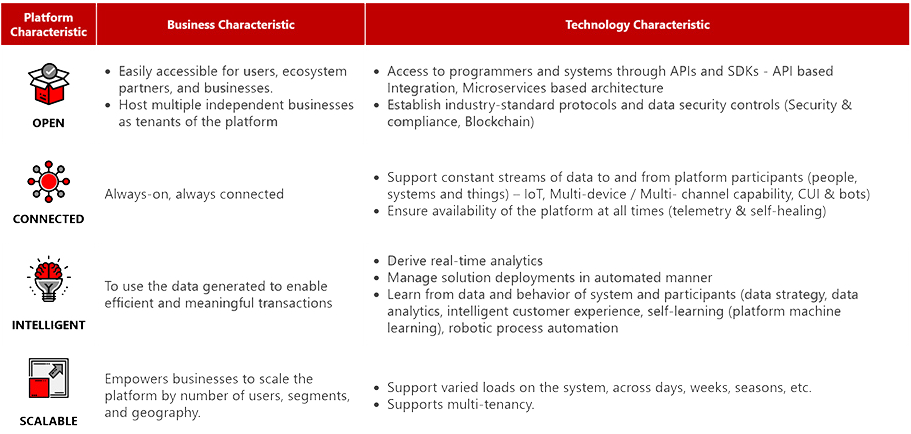
4 Key Elements
- Service Oriented approach (Microservices, Micro front-ends, databases for use cases etc.)
- Layered separation of concern approach (Consumer Layer, Application Layer, Data Layer, Infra Layer, Integration Layer)
- Design-thinking led approach
- Hyper Productivity (Tools and Frameworks)
- Full Automation (Agile and DevOps)
Architectural Patterns
- API-first approach with micro-services architecture for higher flexibility in integrating various systems and composing required platform services
- Cloud-first approach to development and operations minimizing the overheads in managing environments and technology stacks
- Distributed transactions to support events that impact multiple data sources and systems
- Real-time analytics leveraging Big Data and IoT / Telemetry coupled with location sensing technologies that help in providing contextual and personalized user experience, thereby enabling better and faster decision making on the platform
- Self-provisioning cloud infrastructure coupled with micro-services architecture for dynamically scaling specific services based on demand
- Robotic process automation techniques coupled with self-learning systems for reducing manual tasks in executing business processes as well as system operations
Key Constructs
Sonata's Platform Engineering & Architecture Blueprint (PEAB Framework) provides for a robust platform architecture for creating an ecosystem-based model consisting of API, UX, Data, Device/IOT connectivity, Microservices, cloud components and engineering practices for speed and reliability.
API PLATFORM:
Sonata's PEAB framework based on:
- API framework/reference architecture,
- Cloud adoption framework,
- Mobile enablement platform (Halosys),
- IOT reference model
enables building the connected capability of this platform.
UX PLATFORM:
Digital experience must be delivered seamlessly across different devices, channels and should have the ability to connect to different APIs/Services and deliver seamless and native user experience. The intelligent experience to the digital users and adaptability of the application based on the device are some of the key aspects of the UX platform
MICROSERVICES PLATFORM:
Platforms need to be scalable to support new business lines, products, locations, markets and an elastic user base. Sonata's PEAB framework is anchored on Microservices-based architecture and cloud-based platform services. This architecture enables easier adoption of cloud service and architecture innovations that empower scalability.
DATA PLATFORM :
Data is the heart of the platform and hence our data strategy and reference architecture consists of process and tools to Identify, Store, Integrate, Share and Govern Data. This coupled with Robotic Process Automation Framework, Conversational User Interface/Front End Development framework and an engineering process based on contemporary UX design principles, leverage Design Thinking for INTELLIGENT user experience with insights, predictions and recommendations to the user/enterprise. With Machine learning/AI, this intelligence can evolve and mature with time.
INFRASTRUCTURE PLATFORM:
Platform-based Business Model, by its very nature, demands scalable infrastructure based on the demand of the services, duration and the business model requirements. By this definition, Cloud is the infrastructure backbone for platform-based businesses to meet the scalability and connected requirements of the platform.
Modern Engineering Processes:
Modern Engineering Processes based on DevOps, Continuous Integration/Testing, Blue/Green Deployments, Version management , Design Thinking are key aspects of this technology.
Tool/Technology Stack/Assets
Lightning Build Suite – NC/LC Platform
Lightning Build Suite is a set of Sonata's Propitiatory IP to accelerate the Platform Engineering lifecycle
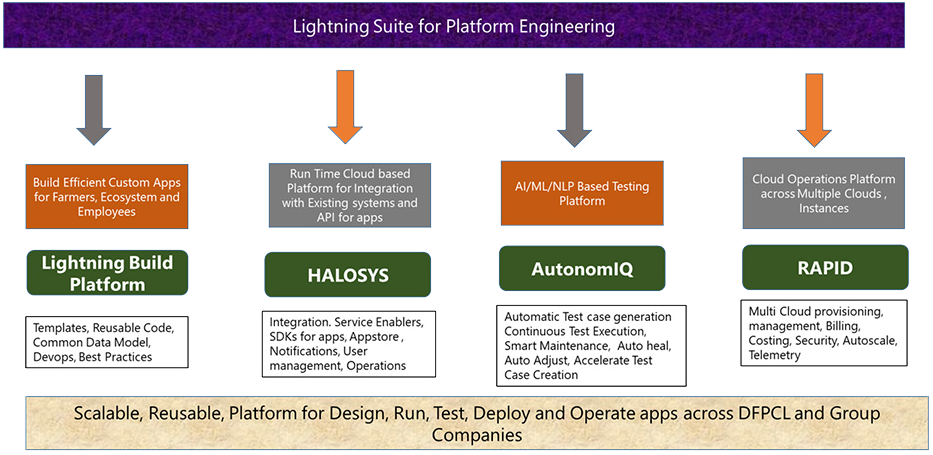
API - Tools/tech Stack/Assets
Tools and Tech Stack:

Frameworks and Assets:
Halosys API Gateway:
- Sonata's Integration and API platform to enable integration to enterprise systems and expose APIs
Assets:
- Sonata API Maturity Framework
- Sonata API Best Practices
Microservices Platform – Tools/Tech Stack/Assets
Tools and Tech Stack:
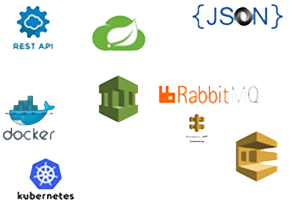
Frameworks and Assets:
- Sonata Microservice Framework
- Sonata Microservice Best Practices, Maturity Model
UX Platform
Tools and Tech Stack:
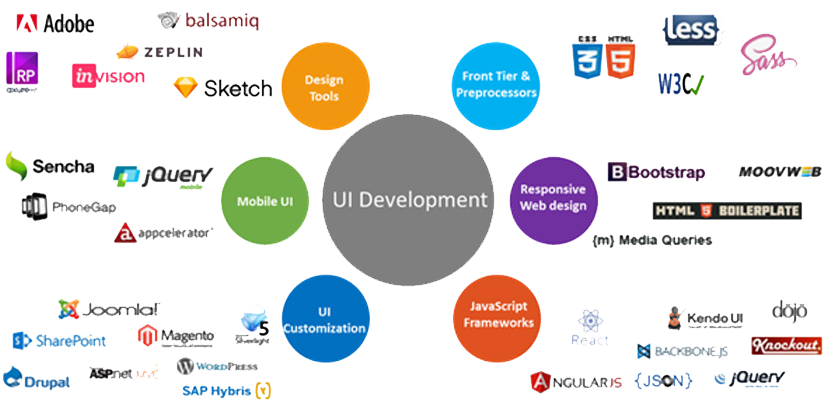
Frameworks and Assets:
- UX assessment Framework
- Design Thinking Framework
- Sonata's Front-End Development Framework- Configurable and Extensible
- Ready to use Design templates
- Rich set of UI Components
- UX Design Best practices
- FED Coding Guidelines
- Style Guides Best Practices
- Device Best practices (Desktop, Apple, Android etc)
- Front End Unit Test Framework
- Chatbot development framework
People Skills
In building and maintaining platforms, apart from tools and processes, people play a key role with their multi-dimensional skills:
- Visualizing the Platform:
Sonatians practice `Design Thinking' and `Business Oriented Empathy' as a way of life to help customers realize their digital Agenda.
- Digital Technology Skills:
State-of-the-art technology skills with the aptitude for problem solving and quick learning are key traits of the people building platforms in Sonata
- FED: HTML, CSS, JavaScript, React, Angular, iOS, Android, ionic, Xamarin
- API/Microservices: Java Spring/Hibernate, ASP .NET, MVC, Azure Services, AWS Services SQL Server, MySQL, PostGres, Oracle, NoSQL, Node.js, Python
- Cloud: AWS Engineering and Operations
- Design Skills: UX, creatives, Graphics
- Digital Engineering Process Skills:
Sonata's tech force is trained in key digital engineering processes which bring in agility for the platform to be built and sustained
- Devops – CI/CD
- Cloud Operations
- Agile Skills
- Collaboration Techniques
Case study(TUI)
- Global Tour Operator and the largest in Europe
- Carries its own inventory of Airlines, Hotels, Resorts and Luxury Yacht
Problem Statement
In 2016/2017, the customer took a strategic decision to move their existing IT infrastructure onto the cloud (specifically Amazon Web Services). This decision was in line with their digital agenda strategy. They created the CMAP (Cloud Migration Adoption Program) to achieve this and its key milestones were:
As part of the mandate above, the customer wanted to modernize the selling and content systems by adopting Platform Based Business Model
- By 2020 – No new hardware to be procured for the On-Premise Data Center
- By 2025 – Decommission the On-Premise Data Center
- Stay ahead of competition by leveraging cloud features
- Make infrastructure more scalable, based on demand
- Setup the supporting ecosystem.
How Sonata Helped achieve Platformation
Sonata conducted 6R analysis of the client's applications and profiled them as digitally-critical and non-critical assets. We charted out their respective modernization and optimization paths for maximum performance.
- Migrate and Optimize: Applications that are non-critical to the client's business and that don't require scale and elasticity to operate optimally in the cloud were migrated and then optimized for cost, infrastructure, resources and process improvements.
- Migrate and Modernize: Applications that require scale and elasticity of cloud and are critical to the business functioning of the customer were modernized to the cloud using Sonata's MARCHITECTURE SONATA SOFTWARE services. These modernized applications incorporate features of modern digital platforms that are Open, Connected, Scalable and Intelligent.
Sonata's analysis covered the following using Sonata's Platform Engineering framework:
- Architecture Analysis,
- Licensing,
- Technology & Tools,
- Security Analysis,
- Cost analysis,
The application chosen to be modernized as a platform was a complex e-commerce based holiday reservation application landscape with integration to on-premise back-office setup.
- Modernize the database from Oracle RDS to AWS Aurora
- Modernize Applications to use Elasticsearch APIs instead of Endeca
- Modern React JS based UI Platform for responsive UX across Channels
- AWS Services used as foundational Building blocks to create Scalable Infrastructure platform.
Unique aspects
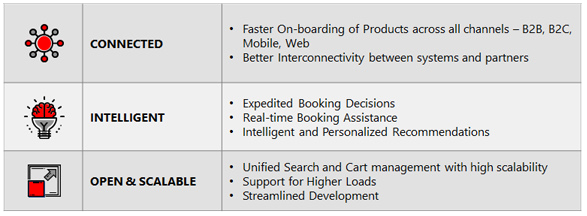
- Consistent application with platform characteristics:
- Application of modern technology and architecture:
- REST APIs for all UI clients communicating with the back-end functional and technical services
- Micro-services for each process step of the travel booking – search, book, card, order, eligibility, insurance etc.
- Micro-services for horizontal business & technology processes such as payment, security etc.
- Loosely coupled modules and services with open standards-based communication / integration between processes & services
Key Artefacts Used:
- MARCHITECTURE SONATA SOFTWARE Services Framework for Tour Operator
- Platform Design Canvas
- Sonata's 16 Point Technology Framework
- Design Thinking Templates – For deriving use cases
- Sonata Accelarate Platform: based on Hybris Travel Accelrator
- Microservice Architecture Framework
Sonata’s PEAB (Platform Engineering Architecture Blueprint) Framework
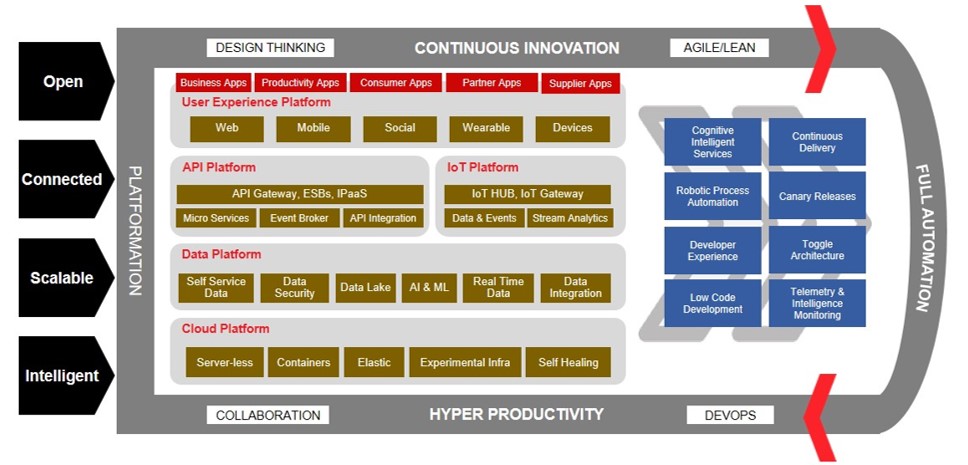
Sonata's Platform Engineering, based on Sonata's Platformation™ framework, help enterprises create Open, Scalable, Connected and Intelligent platform, spread across our 16 point Technology Framework
Technology Framework
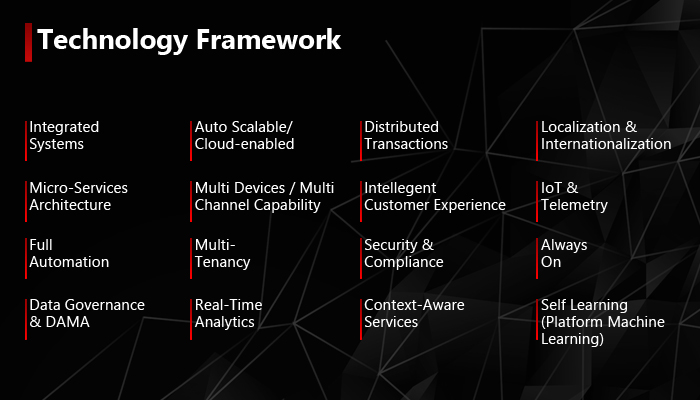
Sonata’s Platform engineering offerings
- Build Modern Infrastructure
- Modernize Application and Engineering
- Provide NextGen Support
Sonata's Platform Engineering Methodology
